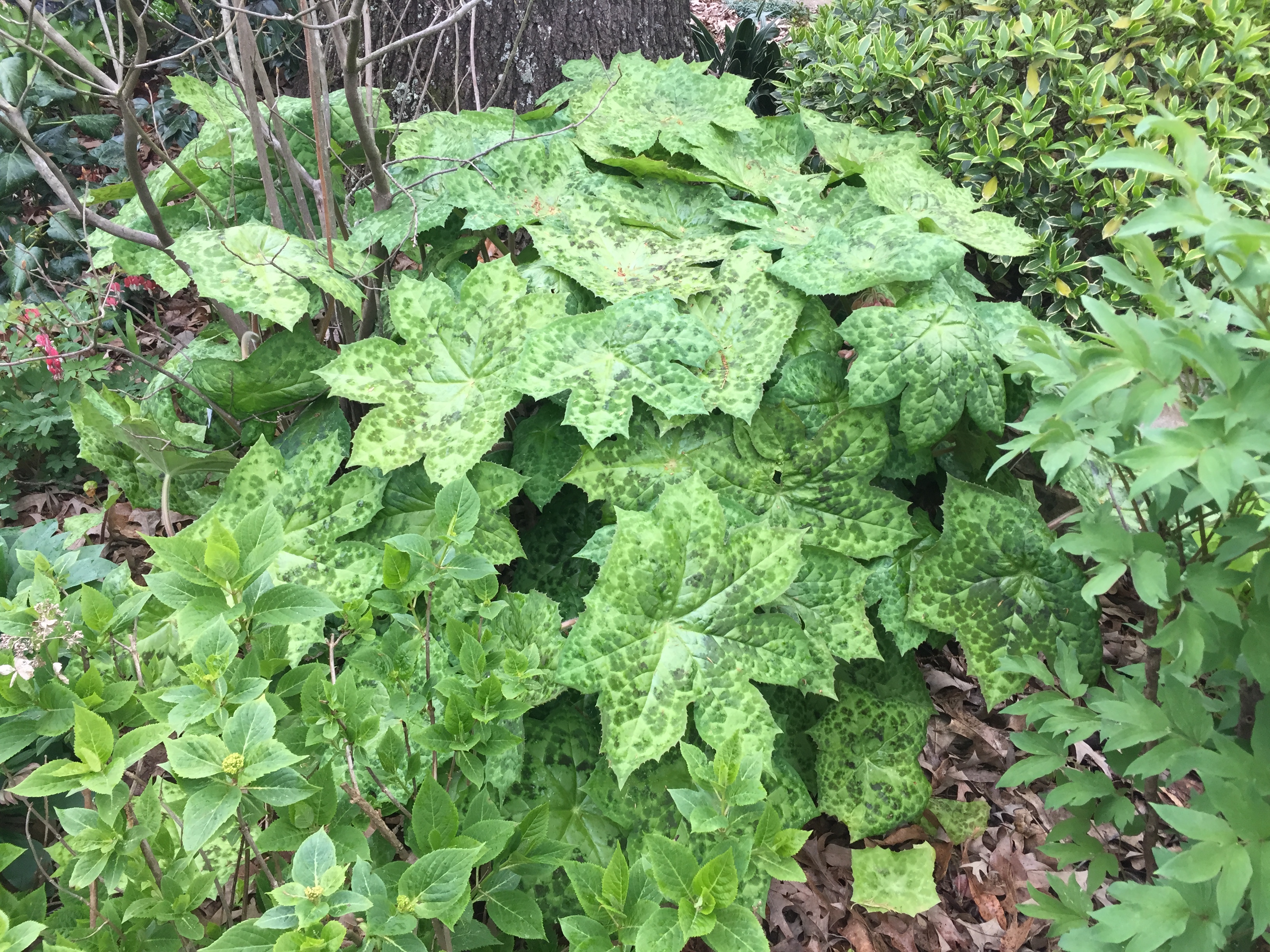Resource Library
Plant of the Week: Podophyllum; “Spotty Dotty,” Spotty Dotty Mayapple
Beautiful leafed plants have always intrigued me. One of the nicest I have seen in recent years is a Chinese mayapple called “Spotty Dotty” (Podophyllum ‘Spotty Dotty’ PP 17,361). This is an interesting perennial for the shade garden that raises all kinds of questions about its place in the world.
Spotty Dotty is an herbaceous perennial in the Barberry family that grows about 18 inches tall and spreads a couple feet across if given sufficient time. It has a rhizomatous root system but its spread is much slower than our native species. In mid-spring it sends up a number of erect growing stems from buds on the rhizome which produce a single, umbrella shaped leaf. The leaf is the size of a dinner plate with six to seven star-shaped points. The leaf surface is marked with blotches of dark and light green and spotted with brown patches as the leaves mature. Unlike our native mayapple, Spotty Dotty does not go dormant and disappear below ground with the first bout of summer heat.
Nodding red flowers are produced at the fork of mature stems beneath the foliage and appear by mid-May. The fruit consists of small clusters of grape sized berries containing multiple seeds.
Spotty Dotty is a 2005 hybrid created by Janet Egger, a plant breeder working for Terra Nova Nursery in Canby, Oregon. As the seed parent she used a seedling from a Japanese nursery with highly marked leaves grown from a hybrid swarm created when three related Chinese species were allowed to interbreed. The pollen parent she used in her controlled cross was P. delavayii, another Chinese species with prominently marked foliage.
In addition to Spotty Dotty, Egger patented more than 20 other plants while working at Terra Nova Nursery. This nursery is best known for its many Heuchera clones but over the past 25 years has introduced more than 1,100 unique perennials. The firm’s success, and the early success of Spotty Dotty in the specialist nursery trade, was due to Terra Nova’s tissue culture lab which made it possible to crank out large numbers of plants in short order.
The half dozen mayapples in Asia grow in a cool, moist mountainous belt of broadleaf forest trees in South China. One of these, P. hexandrum spreads into Indochina, and is genetically similar to our native mayapple. How did these two closely related plants get where they are?
A paper by Wang, and his associates in Beijing and Harvard, attempted to answer this question using DNA analysis. Their data suggests that six Eurasian members of the barberry family separated from their North American cousins 7.5 plus or minus 2.3 million years ago. The theory goes that at one time a pair of land bridges existed between Eurasia and North America and that mayapples grew happily across this vast distance. Given the existence of vast stretches of desert in Western North America, it seems unlikely this moisture loving mayapple came in from the West across the Bering land bridge.
That leaves the eastern land bridge across Greenland, Iceland and into northern Europe. Certainly, the North Atlantic was less open 10 million years ago, but it was still far north. I have trouble seeing this kind of movement without leaving behind pockets of mayapples as either fossils or living plants along the route. My guess is that a belt of early mayapples existed across the Laurasian landmass at about 30⁰N latitude back in the age of the dinosaurs. Over the next 100 million years, plate tectonics separated Eurasia from North American, leaving behind isolated populations of mayapples. So, we still don’t know how mayapples got on opposite sides of the globe, but it is fun to speculate how it may have happened.
Spotty Dotty is a relatively easy to grow mayapple. It should have a moist woodland site with fertile soils. Alternately, it could be planted on the north side of the house in the kind of site where the blue hydrangeas would be expected to thrive. Once established it will tolerate some dry weather, but it should not be subjected to extreme drought. It is a long-lived perennial.
For more information about horticulture or to see other Plant of the Week columns, visit Extension’s Website, www.uaex.uada.edu, or contact your county extension agent. The Cooperative Extension Service is part of the U of A Division of Agriculture.
